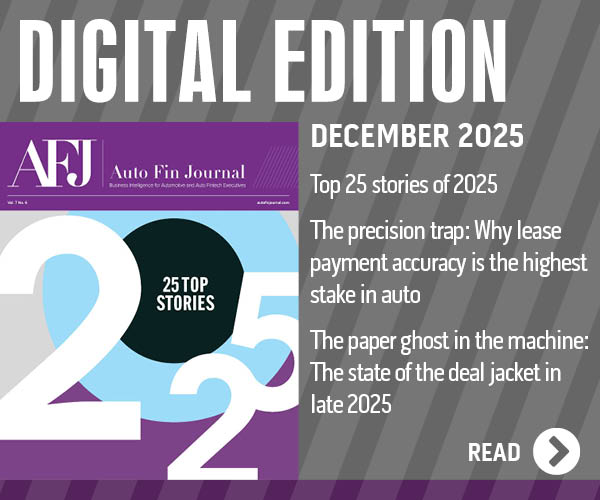EY Global FinTech Adoption Index rises to 64%

By subscribing, you agree to receive communications from Auto Remarketing and our partners in accordance with our Privacy Policy. We may share your information with select partners and sponsors who may contact you about their products and services. You may unsubscribe at any time.
NEW YORK –
Part of the reason Cherokee Media Group launched the Automotive Intelligence Summit: Fintech adoption among consumers has nearly doubled over the past 18 months, according to the latest EY Global FinTech Adoption Index.
EY shared on Monday that the adoption rate is growing faster than anticipated, because 64% of digitally active consumers across 27 markets use fintech, and awareness is even higher globally.
This year, EY added the first-ever Small and Medium-Sized Enterprise (SME) FinTech Adoption Index given fintech’s expansion beyond consumers. EY member firms surveyed more than 1,000 organizations in five countries and found that one-quarter of organizations have used at least one fintech across the following four categories in the past six months: banking and payments, financial management, financing and insurance.
“Fintech organizations are no longer fringe disruptors and have grown into sophisticated competitors,” said Matt Hatch, a partner at Ernst & Young and the EY Americas fintech leader. “Now, financial incumbents are taking note and offering fintech solutions, forming ecosystems that are replacing traditional partnerships.
“We fully expect this trend to accelerate as nonfinancial companies enter the space and leverage technology and innovation to provide frictionless, transparent and highly-personalized services,” Hatch continued.
EY also will have a major presence again this summer during the Automotive Intelligence Summit, which runs July 23-25 in Raleigh, N.C. As the agenda nears completion, a lineup of keynote speakers and panelists have come together that might pique your interest — especially if the following are top of mind for you, your business, or your industry: digital retailing, fintech solutions, cybersecurity, data privacy, customer experience, the future of auto dealerships, Mobility-as-a-Service and more.
Subscribe to Auto Remarketing to stay informed and stay ahead.
By subscribing, you agree to receive communications from Auto Remarketing and our partners in accordance with our Privacy Policy. We may share your information with select partners and sponsors who may contact you about their products and services. You may unsubscribe at any time.
Early bird registration is available through June 7 by going to www.autointelsummit.com.
What’s driving fintech adoption?
EY firms interviewed more than 27,000 people to better understand how consumers are interacting with fintech, and the results are promising, according to the firm.
Based on the survey results, money transfer and payments services continue to be the most popular in both awareness and adoption, as only 4% of global consumers are unaware of at least one money transfer and payment fintech service. EY found that adoption rates continue to lag in the U.S., while Europe’s investments in open banking have contributed to higher adoption rates in that region.
Experts also pointed out that SMEs are further behind in their adoption journey compared to consumers. When an SME uses fintech services, EY explained they have essentially selected this company as an approved vendor, so 25% is considered high, and the adoption rate is expected to climb.
Survey findings showed more than one-fifth (22%) of non-adopters already use fintech services in three of the four categories defined in the survey methodology, which means they are on the verge of becoming fintech adopters.
By this measure, EY calculated the global adoption rate could surge from 25% to 64%.
The impact of trust on fintech adoption
The survey indicated that trust plays a large role in fintech adoption, as non-adopters choose to remain with traditional financial services, because they trust them more than fintech challengers.
EY acknowledged that many fintech propositions rely on data sharing, which can present a barrier for adoption. Nearly half (46%) of adopters are comfortable with their primary banking institution sharing their financial data with other organizations if it means better offers on products or services, but less than a quarter (23%) would share data with nonfinancial services companies.
EY suggested this trust gap can create a huge opportunity for financial institutions and fintech challengers as 31% of adopters say they are willing to share data with fintech challengers. Although nonfinancial services companies might lead innovation, EY said they don’t have full confidence when it comes to providing financial services. Still, 68% of surveyed consumers are willing to consider a financial services product offered by a nonfinancial services company.
The SME FinTech Adoption Index found similar trends. SME FinTech adopters are also more open to sharing data with FinTech companies (89%) and other financial services companies (70%) over nonfinancial services companies (63%).
The future landscape
Looking ahead for both consumers and SMEs, EY highlighted newly developed ecosystems will encourage industry convergence as fintech challengers continue to develop and mature, incumbent companies offer new innovative solutions and nonfinancial services companies expand their offerings.
“We’re optimistic about collaboration between FinTech and traditional financial services companies in the future,” Hatch said. “Just under half (47%) of consumers are happy to use financial services from a nonfinancial services company if that company is working in partnership with the traditional financial services company.
Similarly, SMEs are interested in joining fintech ecosystems that integrate different propositions offered by challengers, incumbents and, in some cases, nonfinancial services companies,” he went on to say. “These ecosystems will continue to make financial services accessible for both consumers and businesses while enhancing the overall experience.”
About the research
The EY study is based on more than 27,000 online interviews with digitally active adults between Feb. 4 and March 11 across 27 markets:
— Argentina
— Australia
— Belgium and Luxembourg (treated as one market)
— Brazil
— Canada
— Chile
— China (mainland)
— Colombia
— France
— Germany
— Hong Kong
— India
— Ireland
— Italy
— Japan
— Mexico
— The Netherlands
— Peru
— Russia
— Singapore
— South Africa
— South Korea
— Spain
— Sweden
— Switzerland
— United Kingdom
— United States
EY explained a regular fintech user is defined as an individual who has used two or more fintech services during the past six months.
The 2019 survey placed fintechs into five categories: money transfer and payments, budgeting and financial planning, savings and investments, borrowing and insurance. There are now 19 individual services, but the survey used the same 10 “buckets” as 2017 to enable year-over-year comparison.
The SME survey is based on 1,000 online interviews with senior decision-makers of SME organizations between Jan. 15 and 30. Senior decision-makers were defined as owners, managing directors, CEOs and other C-level executives responsible for business strategy, operations or financial decisions. An SME fintech adopter was determined to have used services provided by a fintech in all four of the following categories in the past six months: banking and payments, financial management, financing and insurance.


